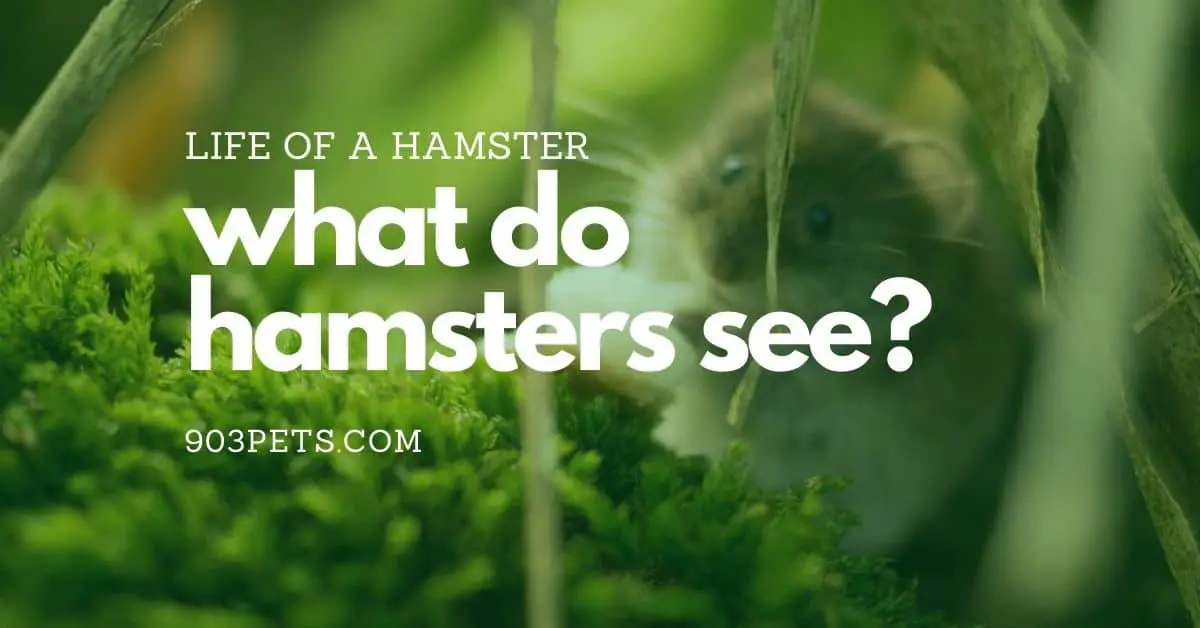The Life of A Hamster: What Do Hamsters See?
Despite the myth, hamsters are not blind, but they do not see the world the way we do.
Hamsters are nearsighted and colorblind, with 97% rod and 3% cone receptors in their eyes. This means they can’t see well beyond a few inches and only see in black, white, and shades of green. However, their poor vision has led to other improved survival senses, such as a keen sense of smell and hearing.
Our first hamster brought lots of laughter and cage cleaning into our lives.

I did wonder how hamsters saw the world. Come to find out, they see their environment in shades of black and white with some greens thrown in. Unfortunately, their eyesight is not great, so it’s hard for them to make out details.
Our Pick For Best Hamster Bedding
Studies and research suggest that paper bedding is best for our hammies. The Carefresh natural paper bedding for small animals is our top pick to use, today.
What We Like:
- Natural paper bedding
- 99% dust free – Reduced cause of respiratory issues for hamsters and human in some cases.
- Up to 10 Days of ammonia odor control
- Good for tunneling and burrowing
- Reduced chance for cuts from sharp portions
- Good absorbency

If you want to learn more about what hamsters see every day, keep reading!
What do hamsters see?
Hamsters have poor eyesight. They see details only at very close distances and cannot recognize their owner’s face more than a few inches away.
Anything more than a few inches away is a blurry, fuzzy, blob that cannot be discerned well.
The hamster’s poor eyesight might help explain why they live in burrows or other places with walls. However, the hamster has excellent hearing and a great sense of smell instead. They use these to survive day-to-day life because they can’t see very well!
But, they can see you if you get close enough.
Do hamsters have good eyesight?
No, not really – a hamster’s vision is quite weak, so it’s hard for them to make out details. Hamsters have eyesight roughly equivalent to a human with 20/400 vision.
20/400 vision means they can only see things in detail a few inches from their face. Anything further away is blurry or nothing more than shadows.

While this may be bad news for the most part, there are some benefits. For instance, since their sight isn’t as sharp as ours when they grow old and become blind, we might not startle them as much as animals with great eyesight.
Can hamsters see in the dark?
No, hamsters cannot see in the dark. However, they can see much better in low-light conditions than humans.
A hamster’s eye contains 97% rods and only 3% cones. Rods are the black and white receptors. Therefore, hamsters can see very well at dawn and dusk, within a few inches of their head, in black and white.
With so many rods, hamsters are not built for daylight activity. This, combined with hamsters being prey animals, helps explain their activity primarily in dusk or dawn lighting scenarios.
Are Hamsters color blind?
Yes, sort of. Hamsters have some color vision, but not as much as people. They are most likely able to see greens the best while they have difficulty distinguishing other colors from each other.
Not all hamsters see any colors at all. The Syrian hamster sees in shades of green, and the Siberian hamster has vision that encompasses the blue and ultraviolet parts of the light spectrum. No hamsters can see reds.
Hamsters are not able to see many colors because their eyes contain very few cone receptors. Cones are the “color” detecting receptors in the eye.
Why do hamsters have poor eyesight?
Hamster’s eye is less spherical than ours, so it does not focus light like our eye would when looking at objects close by or far away. So the cornea only appears biconvex, sort of like a lentil, convex on both sides, when the reality is it is less round.
The cornea and lens of the eye focus light onto the retina. When the light is unfocused, the images the brain detects are fuzzy and misshapen.
The retina of a hamster’s eye is considered Holangiotic which means: “…with blood vessels distributed throughout most of the neurosensory retina, supplying the inner retina only.” – Science Direct
How do hamsters survive with such poor eyesight?
Hamsters may not have the best eyesight, but they make up for it by using their other senses.
The sense of smell in hamsters is thought to be stronger than in other animals. Hamsters use their sense of smell to help them recognize food, other hamsters and find their burrows. They also use it to recognize their owners.
Hamsters also have a great sense of hearing. They can hear high frequencies that you and I cannot.
Ever notice that when you make a sudden noise, your hamster stops, sits perfectly still, and begins to sniff the air? This is because hamsters are prey animals, and a loud noise might be the sound of an animal predator. Your hamster is trying to figure that out.
The whiskers, or vibrissae, help the hamster detect objects around them. These sensitive hairs extend from the hamster’s muzzle.
In order for a hamster to survive, they need their whiskers and their sense of hearing and smell to find food or avoid predators. When living with humans, the hamsters have an advantage because they can rely on our human senses too!
Conclusion: What Do Hamsters See?
Hamsters have vision that is much worse than what you and I can see. They also don’t see colors as well or at all, but they do have a sense of nighttime sight which helps them find food in the dark.
Hamsters are prey animals, so they rely on their whiskers, hearing, and sense of smell to avoid predators and other dangers around them. So if your hamster starts sniffing when it hears sudden noises, then it’s probably just trying to figure out if there is any danger nearby for both themselves and you!
So while we might call our hamster blind because it doesn’t see color or anything very clearly, this isn’t true – they’re not blind at all! It’s just different from how humans experience life with our normal eyes.
Related Questions
Does blue light affect hamsters? Yes, one study showed that blue light might cause depression-like characteristics in hamsters. So, keep the UV and blue colored lights away from your hamster. Dim light is the sweet spot for them.
If you think your pet is ill, call a vet immediately. All health-related questions should be referred to your veterinarian. They can examine your pet, understand its health history, and make well informed recommendations for your pet.
903pets.com Staff


![How Much Do I Feed My Hamster [Food and Water Guide] 4 How much to feed pet hamsters - food and water guide](https://cdn-0.903pets.com/ifywhoft/2022/01/How-much-to-feed-pet-hamsters-768x402.jpg)

![How Big Do Hamsters Get - Sizes Of All 19 Major Breeds [Tables] 8 How big do hamsters grow breed size chart](https://cdn-0.903pets.com/ifywhoft/2021/06/Hamster-breed-size-chart.-How-big-do-hamsters-get-768x402.jpg)
![How to Pet a Hamster: 9 Happy vs. Unhappy Signs 10 Do hamsters like to be petted and held? [Answers]](https://cdn-0.903pets.com/ifywhoft/2021/05/How-to-Pet-a-Hamster-Happy-vs.-Unhappy-Signs-768x402.jpg)
![What Do Hamsters Eat [Do's and Don'ts] 12 What Can Hamster Eat Dos and Donts](https://cdn-0.903pets.com/ifywhoft/2022/01/What-Can-Hamster-Eat-Dos-and-Donts-768x402.jpg)
